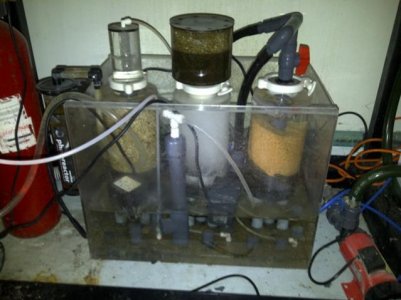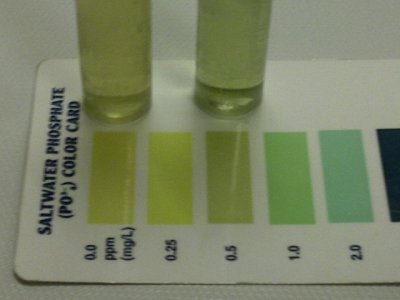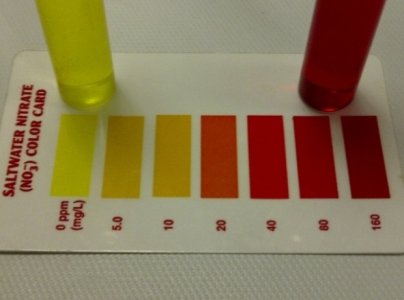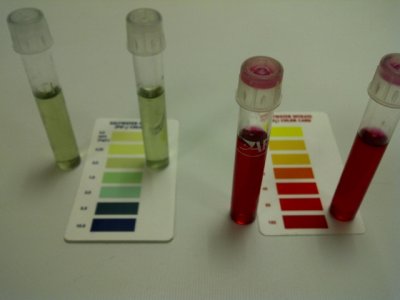Hi Folks - I've been following this thread with great interest. I recall the discussion about removing filter socks due to rapid clogging by bacteria; however I don't recall whether the recommendation was to get rid of mechanical filtration entirely...?
I've been running about 2L of biopellets (SWC & Vertex mixed) on a 500 Gallon system for about 4-5 weeks now... for what it's worth I had a smaller amount running on the system for about a month before but there have been many flow and arrangement adjustments as this also happens to be a proto-type filtration system that I am constantly tinkering with. In addition to the biopellets, I've also been running Phosban GFO in a reactor.
Before I started my recent rehabilitation intervention on this particular aquarium, nitrates were way the hell off the chart - I would guesstimate well over 200 ppm on API; and phosphate was probably close to 1ppm. After a couple of quick GFO replenishments the phosphate is now around 0.5ppm, and after about a month of running the current amount of bp, the nitrates are somewhere between 80-100ppm.
I originally started the system with MB7; but currently dose about 20 drops of Zeobak a few times a week. I also occasionally attempt to supercharge the pellets by putting them in a pail of aquarium water over night and adding a disproportionately large amount of zeobak to the bucket (with aquarium water of course)....
WELL here's the interesting part: since I was not sure exactly why my nitrates and phosphates were dropping at such an undetectable rate over the course of more than a month of relatively stable operation - I decided to test the water in the pail I was super-charging. Here are the results:
This is my proto-type filtration system which has been added onto a 450 gallon aquarium - there is another sump attached which just houses a heater and some mechanical filtration (filter floss on top of engineering foam)
View attachment 131543
I placed the entire reactor worth of bp into a 5 gallon pail with only a covering of water and about 25 drops of Zeobak to supercharge. This was actually just started off as one of my regular supercharge routines but then I serendipitously decided to test for NO3 & PO4 - as it turned out the nitrate was absolute 0 and the PO4 was way the heck off the chart... some kind of deep deep purple. Finding this interesting, I repeated the experiment with a little more water and inserted a little maxijet powerhead... the following photos display the results after about 12 hours (the 0 readings are from the pail - yes even the phosphate was 0; and the high readings were from the aquarium water; both samples tested simultaneously):
View attachment 131544
View attachment 131545
At this point I was thoroughly confused so I repeated the experiment, but this time removed the bp and only added zeobak and kept the powerhead:
View attachment 131546
This was also left for about 12 hours; and as you can see there is no change from the water in the tank to the water circulating with the zeobak.... this saved me one more test as I could then deduct that the zeobak was not responsible for processing out the NO3/PO4 in the previous test; but was in fact the bacteria that would be present on the bp...
However the bp reactor when running on my 500 total gallon system does not make noticeable strides on the NO3/PO4 on the system - although I do believe it is dropping the values sssslooooowwwwwly....
Soooo I'm left with (and of course am requesting your input on) the following possibilities:
- Either the approx. 2L of Biopellets that my reactor can handle is not enough to drop the nutrients quickly on a large system that has been nutrient neglected for the better part of 6 years; or
- My filter floss/engineering foam mechanical filtration is adversely affecting the process even though 100% of the effluent from the reactor is fed directly into the skimmer with 0 exception. Incidentally the skimmate in the first photo is little more than 48 hours worth.
As can be determined from my mini experiments, the biopellets are in fact 'ignited' and functioning. If they can remove approx. 100 ppm of NO3 from 3 gallons of water in under 12 hours, then there must be some other factor at play that is preventing the same results in the actual display tank after more than a month (albeit a large [500G] system). I removed the mechanical filtration from the first filtration chamber yesterday, so if I see noticeable change over the course of this week - then perhaps it can be determined that a bp system needs to run entirely on skimming and GAC filtration alone... i.e. no mechanical filtration whatsoever....? does this sound reasonable to y'all operating with success out there. Please advise on the level of mechanical filtration that should be employed.
Thanks in advance.
Sheldon.
P.S. Did I mention that this is a spectacular thread...!!!
P.S.S. As you can tell from my post count I do a lot more reading than contributing - please don't hold it against me as I still consider myself a reefkeeping student.... SJ :rolleye1:




